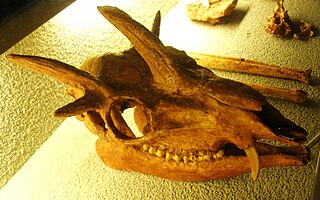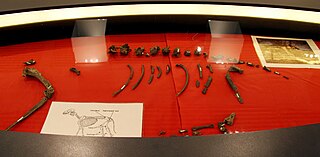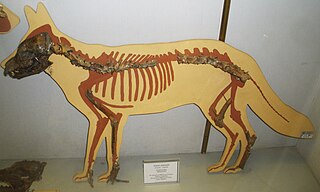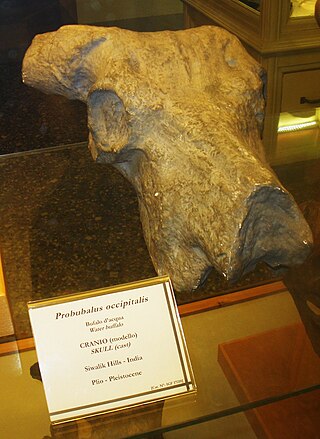
Homotherium is an extinct genus of machairodontine scimitar-toothed cat that inhabited North America, South America, Eurasia, and Africa during the Pliocene and Pleistocene epochs from around 4 million to 12,000 years ago. In comparison to Smilodon, the canines of Homotherium were shorter, and it was probably adapted to running down rather than ambushing prey.

The subfamily Caprinae, also sometimes referred to as the tribe Caprini, is part of the ruminant family Bovidae, and consists of mostly medium-sized bovids. A member of this subfamily is called a caprine.

The Bovidae comprise the biological family of cloven-hoofed, ruminant mammals that includes cattle, yaks, bison, buffalo, antelopes, sheep and goats. A member of this family is called a bovid. With 143 extant species and 300 known extinct species, the family Bovidae consists of 11 major subfamilies and thirteen major tribes. The family evolved 20 million years ago, in the early Miocene.

Musk deer can refer to any one, or all seven, of the species that make up Moschus, the only extant genus of the family Moschidae. Despite being commonly called deer, they are not true deer belonging to the family Cervidae, but rather their family is closely related to Bovidae, the group that contains antelopes, bovines, sheep, and goats. The musk deer family differs from cervids, or true deer, by lacking antlers and preorbital glands also, possessing only a single pair of teats, a gallbladder, a caudal gland, a pair of canine tusks and—of particular economic importance to humans—a musk gland.

Equisetaceae, also known as the horsetail family, is a family of ferns and the only surviving family of the order Equisetales, with one surviving genus, Equisetum, comprising about twenty species.

The muskox, also spelled musk ox and musk-ox, plural muskoxen or musk oxen, is a hoofed mammal of the family Bovidae. Native to the Arctic, it is noted for its thick coat and for the strong odor emitted by males during the seasonal rut, from which its name derives. This musky odor has the effect of attracting females during mating season. Its Inuktitut name "umingmak" translates to "the bearded one".

The steppe bison or steppe wisent is an extinct species of bison that was once found on the mammoth steppe where its range included British Isles, Europe, Central Asia, Northern to Northeastern Asia including the Japanese archipelago, Beringia, and central North America, from northwest Canada to Mexico during the Quaternary. This wide distribution is sometimes called the Pleistocene bison belt, compared to the Great bison belt. It is ancestral to modern American bison. Three chronological subspecies, Bison priscus priscus, Bison priscus mediator, and Bison priscus gigas, have been suggested.

Myotragus is an extinct genus of goat-antelope in the tribe Caprini which lived on the Balearic Islands of Mallorca and Menorca in the western Mediterranean until its extinction around 4,500 years ago. The fossil record of Myotragus on the Balearic Islands extends over 5 million years back to the early Pliocene on Mallorca, where it presumably arrived after the evaporation of the Mediterranean Sea during the Messinian Salinity Crisis.

Nuralagus is an extinct genus of leporid, with a single species, Nuralagus rex, described in 2011. It lived on Menorca, one of the Balearic Islands in the western Mediterranean during the Pliocene epoch. It is the largest known lagomorph to have ever existed, with an estimated weight of 8–12 kilograms (18–26 lb), nearly double the weight of the average Flemish Giant rabbit. It likely went extinct at the Pliocene-Pleistocene transition when Mallorca and Menorca were united as one island, letting the mammalian fauna of Mallorca, including the goat-like ungulate Myotragus, colonize Nuralagus's habitat.

Bootherium is an extinct bovid genus from the middle to late Pleistocene of North America which contains a single species, Bootherium bombifrons. Vernacular names for Bootherium include Harlan's muskox, woodox, woodland muskox, helmeted muskox, or bonnet-headed muskox.

Xenocyon is an extinct group of canids, either considered a distinct genus or a subgenus of Canis. The group includes Canis (Xenocyon) africanus, Canis (Xenocyon) antonii and Canis (Xenocyon) falconeri that gave rise to Canis (Xenocyon) lycanoides. The hypercarnivorous Xenocyon is thought to be closely related and possibly ancestral to modern dhole and the African wild dog, as well as the insular Sardinian dhole.

Hoplitomeryx is a genus of extinct deer-like ruminants which lived on the former Gargano Island during the Miocene and the Early Pliocene, now a peninsula on the east coast of South Italy. Hoplitomeryx, also known as "prongdeer", had five horns and sabre-like upper canines similar to a modern musk deer.

Lycaon sekowei is an extinct canid species from southern Africa that lived during the early Pleistocene epoch, dating from 2 to 1 million years ago.

Soergelia is a genus of extinct ovibovine caprine that was common across Europe, North America and Asia in the Pleistocene epoch.

Canis arnensis, the Arno River dog, is an extinct species of canine that was endemic to Mediterranean Europe during the Early Pleistocene. The Arno River dog has been described as a small jackal-like dog. Its anatomy and morphology relate it more to the modern golden jackal than to the larger Etruscan wolf of that time. It is probably the ancestor of modern jackals.

Canis etruscus, the Etruscan wolf, is an extinct species of canine that was endemic to Mediterranean Europe during the Early Pleistocene. The Etruscan wolf has been described as a small wolf-like dog. The Etruscan wolf has been accepted as the ancestor of C. mosbachensis, that is the ancestor of the grey wolf, for a long time. Recent research has suggested that C. borjgali from Dmanisi has to be considered the ancestor of C. mosbachensis.

Hemibos is an extinct even-toed ungulate belonging to the family Bovidae. Its fossil remains were found across Asia and Europe such as from China, Italian Peninsula, Iberian Peninsula, and State of Palestine, Israel, Pakistan, India.
Capra dalii is a fossil species of goat discovered in Georgia in 2006. It is named for the Georgian goddess Dali, who was considered the guardian of hoofed animals such as ibexes and goats. Fragments of C. dalii fossils were first located at the Dmanisi archaeological site, and are believed to be related to the west Caucasian tur, Capra caucasica. The species is believed to have existed during the Early Pleistocene, around 1.76 million years ago, making it the oldest known example of the Capra genus.
Bolt's Farm is a palaeontological site in the Cradle of Humankind World Heritage Site, Gauteng province, South Africa. With more than 30 fossil deposits dating back 4.5 Ma, it is one of the oldest sites currently discovered in the Cradle of Humankind. It consists of multiple cavities, pits, and quarries, where caves have eroded away, exposing their fossiliferous interiors. Although this site has not yet yielded the hominid fossils for which the Cradle of Humankind is known, Bolt's Farm is still an important source of fossils from various species of Early Pliocene and Plio-Pleistocene fauna, including primates and big cats.
Minnaar's Cave, or simply Minnaar, is a palaeontological site located in the Cradle of Humankind World Heritage Site, Gauteng province, South Africa. Lost after its discovery in the 1930s, its location was rediscovered in 2009. It is known for its well-preserved jackal skulls, dating to the Plio-Pleistocene at least 2 million years ago.

















